The Australian Housing Market: Macroeconomic Implications and Policies
VerifiedAdded on 2023/01/18
|8
|1698
|82
Essay
AI Summary
This essay delves into the macroeconomic implications of the 2017-onward decline in Australia's housing market. It examines how the property price bust affects key macroeconomic variables, including output, unemployment, the exchange rate, and the current account balance. The analysis consi...
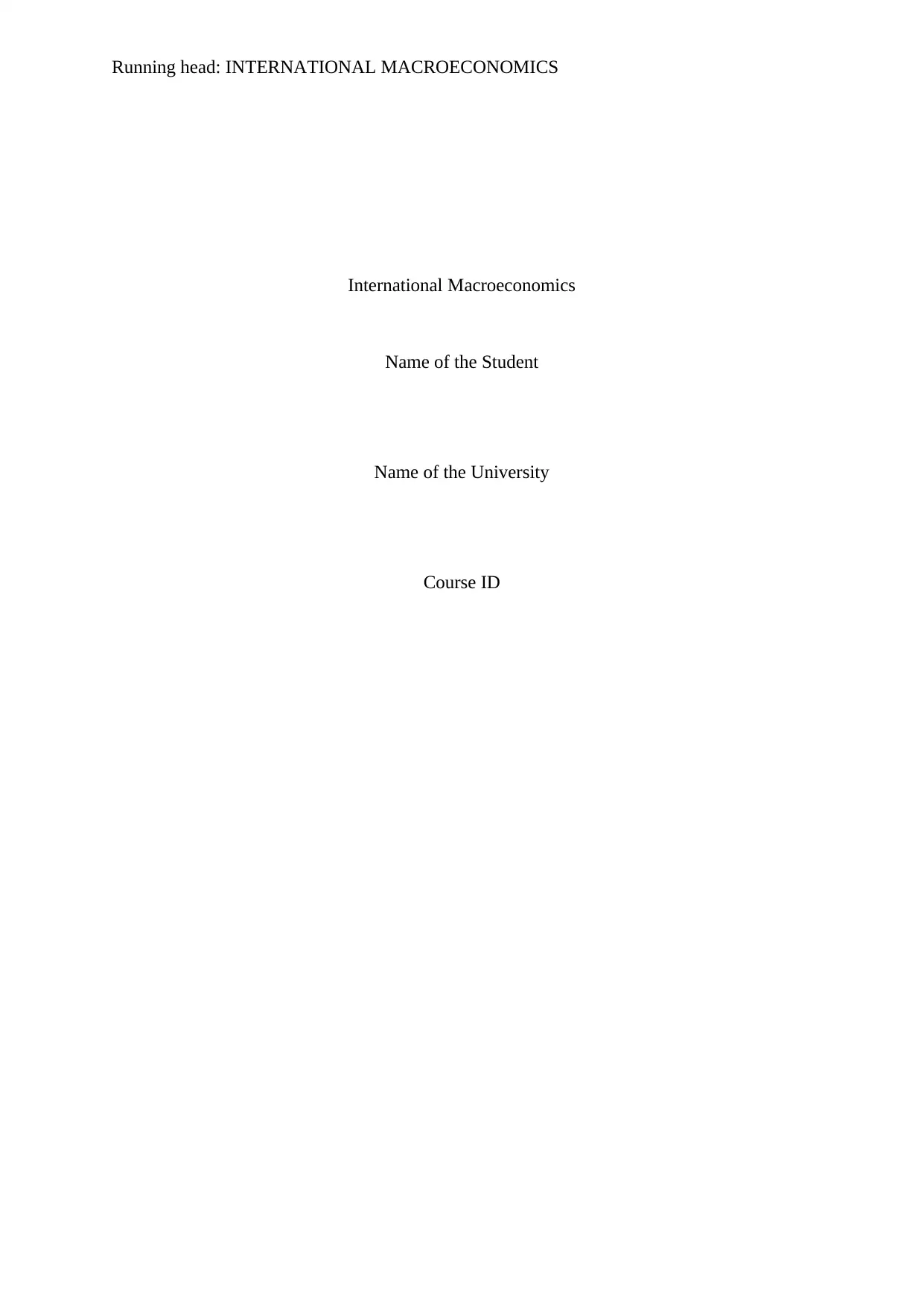
Running head: INTERNATIONAL MACROECONOMICS
International Macroeconomics
Name of the Student
Name of the University
Course ID
International Macroeconomics
Name of the Student
Name of the University
Course ID
Paraphrase This Document
Need a fresh take? Get an instant paraphrase of this document with our AI Paraphraser
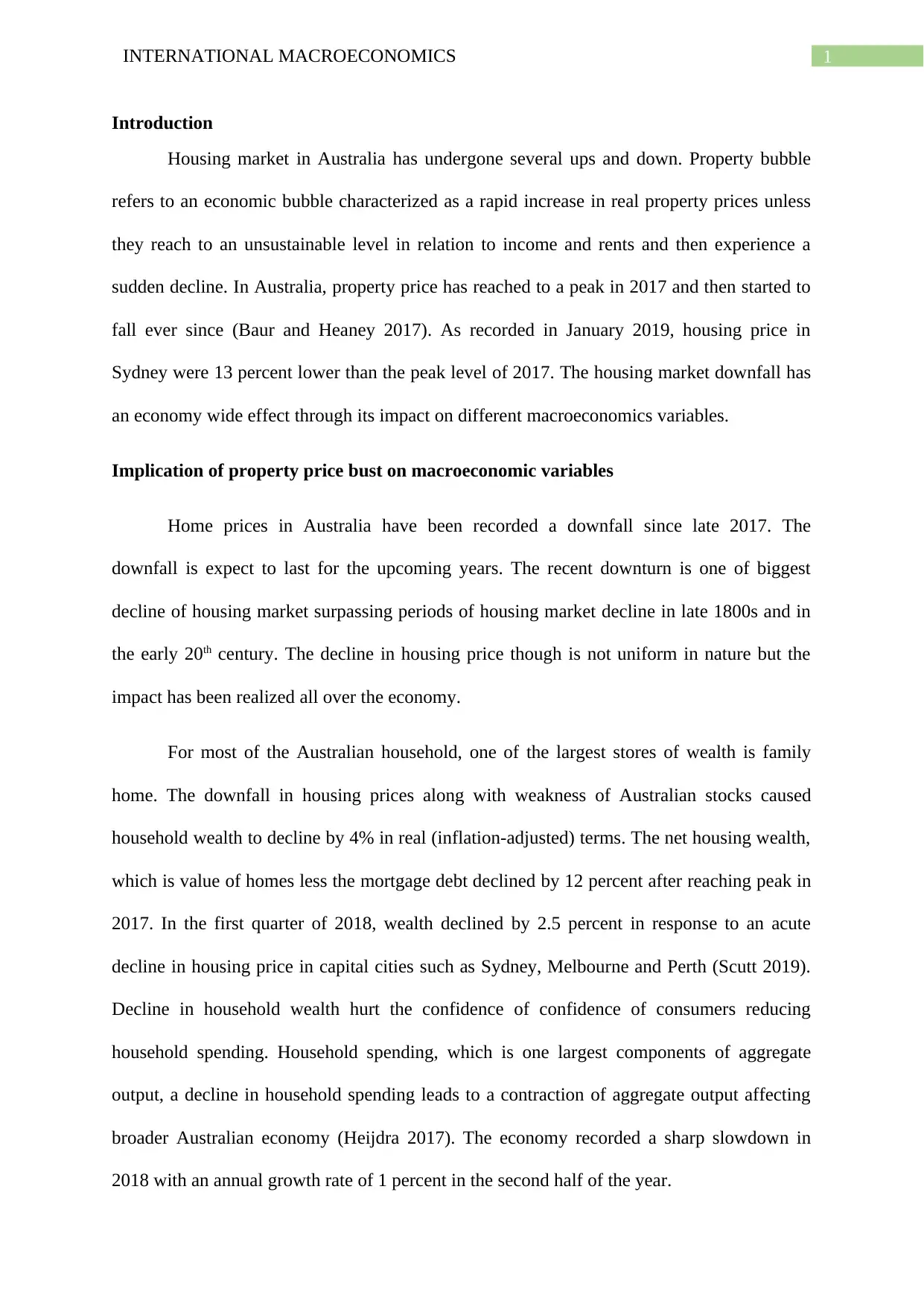
1INTERNATIONAL MACROECONOMICS
Introduction
Housing market in Australia has undergone several ups and down. Property bubble
refers to an economic bubble characterized as a rapid increase in real property prices unless
they reach to an unsustainable level in relation to income and rents and then experience a
sudden decline. In Australia, property price has reached to a peak in 2017 and then started to
fall ever since (Baur and Heaney 2017). As recorded in January 2019, housing price in
Sydney were 13 percent lower than the peak level of 2017. The housing market downfall has
an economy wide effect through its impact on different macroeconomics variables.
Implication of property price bust on macroeconomic variables
Home prices in Australia have been recorded a downfall since late 2017. The
downfall is expect to last for the upcoming years. The recent downturn is one of biggest
decline of housing market surpassing periods of housing market decline in late 1800s and in
the early 20th century. The decline in housing price though is not uniform in nature but the
impact has been realized all over the economy.
For most of the Australian household, one of the largest stores of wealth is family
home. The downfall in housing prices along with weakness of Australian stocks caused
household wealth to decline by 4% in real (inflation-adjusted) terms. The net housing wealth,
which is value of homes less the mortgage debt declined by 12 percent after reaching peak in
2017. In the first quarter of 2018, wealth declined by 2.5 percent in response to an acute
decline in housing price in capital cities such as Sydney, Melbourne and Perth (Scutt 2019).
Decline in household wealth hurt the confidence of confidence of consumers reducing
household spending. Household spending, which is one largest components of aggregate
output, a decline in household spending leads to a contraction of aggregate output affecting
broader Australian economy (Heijdra 2017). The economy recorded a sharp slowdown in
2018 with an annual growth rate of 1 percent in the second half of the year.
Introduction
Housing market in Australia has undergone several ups and down. Property bubble
refers to an economic bubble characterized as a rapid increase in real property prices unless
they reach to an unsustainable level in relation to income and rents and then experience a
sudden decline. In Australia, property price has reached to a peak in 2017 and then started to
fall ever since (Baur and Heaney 2017). As recorded in January 2019, housing price in
Sydney were 13 percent lower than the peak level of 2017. The housing market downfall has
an economy wide effect through its impact on different macroeconomics variables.
Implication of property price bust on macroeconomic variables
Home prices in Australia have been recorded a downfall since late 2017. The
downfall is expect to last for the upcoming years. The recent downturn is one of biggest
decline of housing market surpassing periods of housing market decline in late 1800s and in
the early 20th century. The decline in housing price though is not uniform in nature but the
impact has been realized all over the economy.
For most of the Australian household, one of the largest stores of wealth is family
home. The downfall in housing prices along with weakness of Australian stocks caused
household wealth to decline by 4% in real (inflation-adjusted) terms. The net housing wealth,
which is value of homes less the mortgage debt declined by 12 percent after reaching peak in
2017. In the first quarter of 2018, wealth declined by 2.5 percent in response to an acute
decline in housing price in capital cities such as Sydney, Melbourne and Perth (Scutt 2019).
Decline in household wealth hurt the confidence of confidence of consumers reducing
household spending. Household spending, which is one largest components of aggregate
output, a decline in household spending leads to a contraction of aggregate output affecting
broader Australian economy (Heijdra 2017). The economy recorded a sharp slowdown in
2018 with an annual growth rate of 1 percent in the second half of the year.
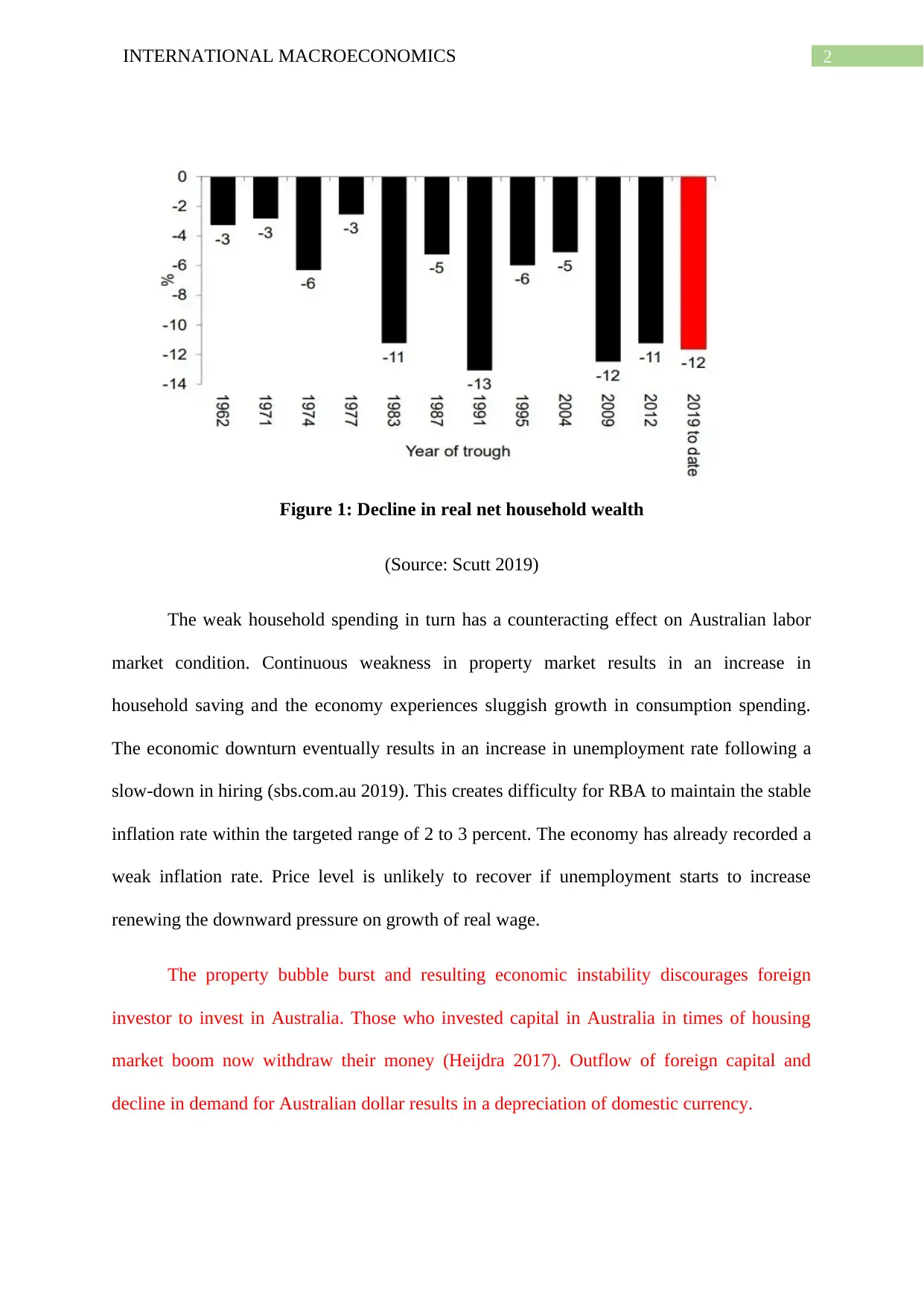
2INTERNATIONAL MACROECONOMICS
Figure 1: Decline in real net household wealth
(Source: Scutt 2019)
The weak household spending in turn has a counteracting effect on Australian labor
market condition. Continuous weakness in property market results in an increase in
household saving and the economy experiences sluggish growth in consumption spending.
The economic downturn eventually results in an increase in unemployment rate following a
slow-down in hiring (sbs.com.au 2019). This creates difficulty for RBA to maintain the stable
inflation rate within the targeted range of 2 to 3 percent. The economy has already recorded a
weak inflation rate. Price level is unlikely to recover if unemployment starts to increase
renewing the downward pressure on growth of real wage.
The property bubble burst and resulting economic instability discourages foreign
investor to invest in Australia. Those who invested capital in Australia in times of housing
market boom now withdraw their money (Heijdra 2017). Outflow of foreign capital and
decline in demand for Australian dollar results in a depreciation of domestic currency.
Figure 1: Decline in real net household wealth
(Source: Scutt 2019)
The weak household spending in turn has a counteracting effect on Australian labor
market condition. Continuous weakness in property market results in an increase in
household saving and the economy experiences sluggish growth in consumption spending.
The economic downturn eventually results in an increase in unemployment rate following a
slow-down in hiring (sbs.com.au 2019). This creates difficulty for RBA to maintain the stable
inflation rate within the targeted range of 2 to 3 percent. The economy has already recorded a
weak inflation rate. Price level is unlikely to recover if unemployment starts to increase
renewing the downward pressure on growth of real wage.
The property bubble burst and resulting economic instability discourages foreign
investor to invest in Australia. Those who invested capital in Australia in times of housing
market boom now withdraw their money (Heijdra 2017). Outflow of foreign capital and
decline in demand for Australian dollar results in a depreciation of domestic currency.
You're viewing a preview
Unlock full access by subscribing today!
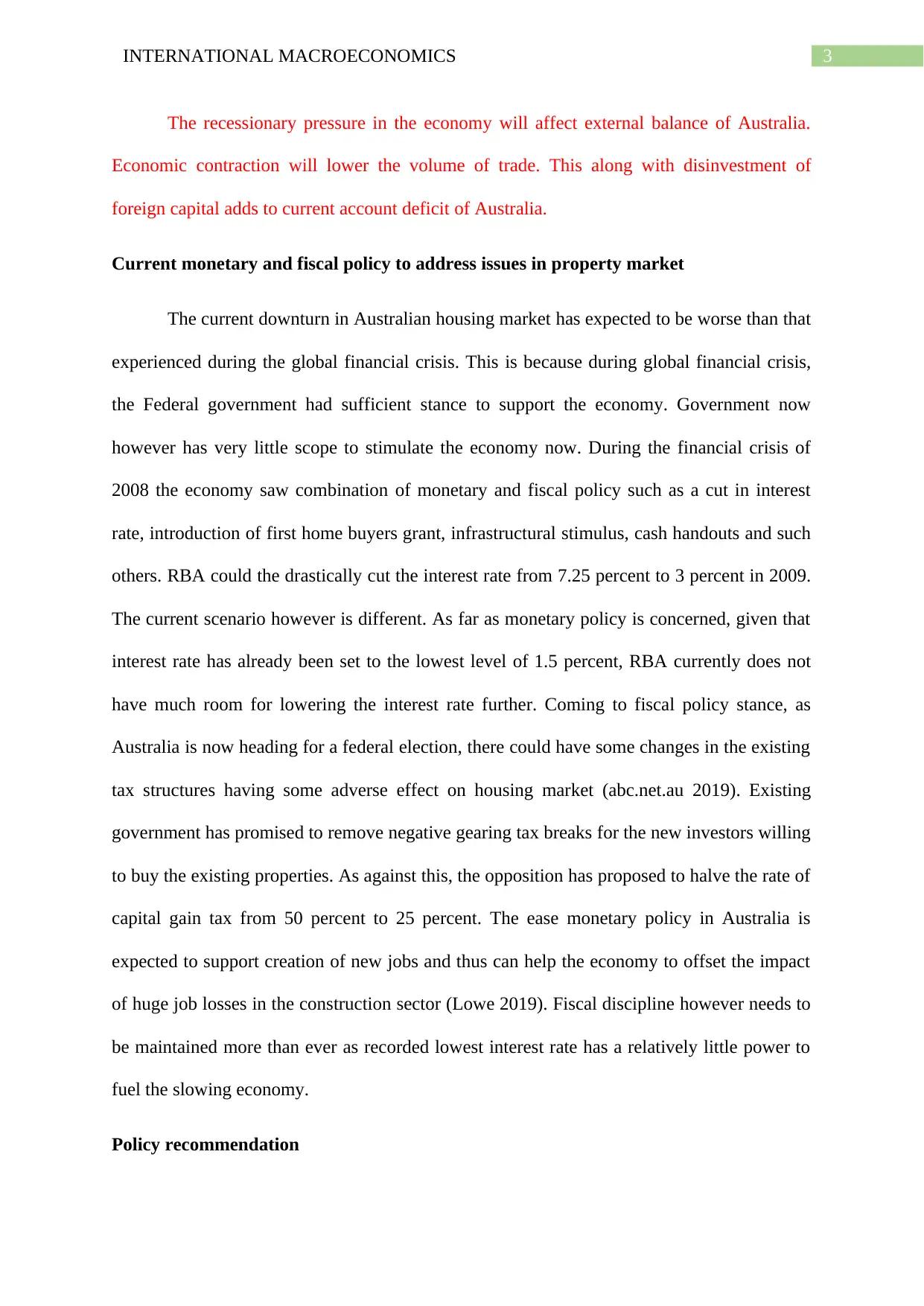
3INTERNATIONAL MACROECONOMICS
The recessionary pressure in the economy will affect external balance of Australia.
Economic contraction will lower the volume of trade. This along with disinvestment of
foreign capital adds to current account deficit of Australia.
Current monetary and fiscal policy to address issues in property market
The current downturn in Australian housing market has expected to be worse than that
experienced during the global financial crisis. This is because during global financial crisis,
the Federal government had sufficient stance to support the economy. Government now
however has very little scope to stimulate the economy now. During the financial crisis of
2008 the economy saw combination of monetary and fiscal policy such as a cut in interest
rate, introduction of first home buyers grant, infrastructural stimulus, cash handouts and such
others. RBA could the drastically cut the interest rate from 7.25 percent to 3 percent in 2009.
The current scenario however is different. As far as monetary policy is concerned, given that
interest rate has already been set to the lowest level of 1.5 percent, RBA currently does not
have much room for lowering the interest rate further. Coming to fiscal policy stance, as
Australia is now heading for a federal election, there could have some changes in the existing
tax structures having some adverse effect on housing market (abc.net.au 2019). Existing
government has promised to remove negative gearing tax breaks for the new investors willing
to buy the existing properties. As against this, the opposition has proposed to halve the rate of
capital gain tax from 50 percent to 25 percent. The ease monetary policy in Australia is
expected to support creation of new jobs and thus can help the economy to offset the impact
of huge job losses in the construction sector (Lowe 2019). Fiscal discipline however needs to
be maintained more than ever as recorded lowest interest rate has a relatively little power to
fuel the slowing economy.
Policy recommendation
The recessionary pressure in the economy will affect external balance of Australia.
Economic contraction will lower the volume of trade. This along with disinvestment of
foreign capital adds to current account deficit of Australia.
Current monetary and fiscal policy to address issues in property market
The current downturn in Australian housing market has expected to be worse than that
experienced during the global financial crisis. This is because during global financial crisis,
the Federal government had sufficient stance to support the economy. Government now
however has very little scope to stimulate the economy now. During the financial crisis of
2008 the economy saw combination of monetary and fiscal policy such as a cut in interest
rate, introduction of first home buyers grant, infrastructural stimulus, cash handouts and such
others. RBA could the drastically cut the interest rate from 7.25 percent to 3 percent in 2009.
The current scenario however is different. As far as monetary policy is concerned, given that
interest rate has already been set to the lowest level of 1.5 percent, RBA currently does not
have much room for lowering the interest rate further. Coming to fiscal policy stance, as
Australia is now heading for a federal election, there could have some changes in the existing
tax structures having some adverse effect on housing market (abc.net.au 2019). Existing
government has promised to remove negative gearing tax breaks for the new investors willing
to buy the existing properties. As against this, the opposition has proposed to halve the rate of
capital gain tax from 50 percent to 25 percent. The ease monetary policy in Australia is
expected to support creation of new jobs and thus can help the economy to offset the impact
of huge job losses in the construction sector (Lowe 2019). Fiscal discipline however needs to
be maintained more than ever as recorded lowest interest rate has a relatively little power to
fuel the slowing economy.
Policy recommendation
Paraphrase This Document
Need a fresh take? Get an instant paraphrase of this document with our AI Paraphraser
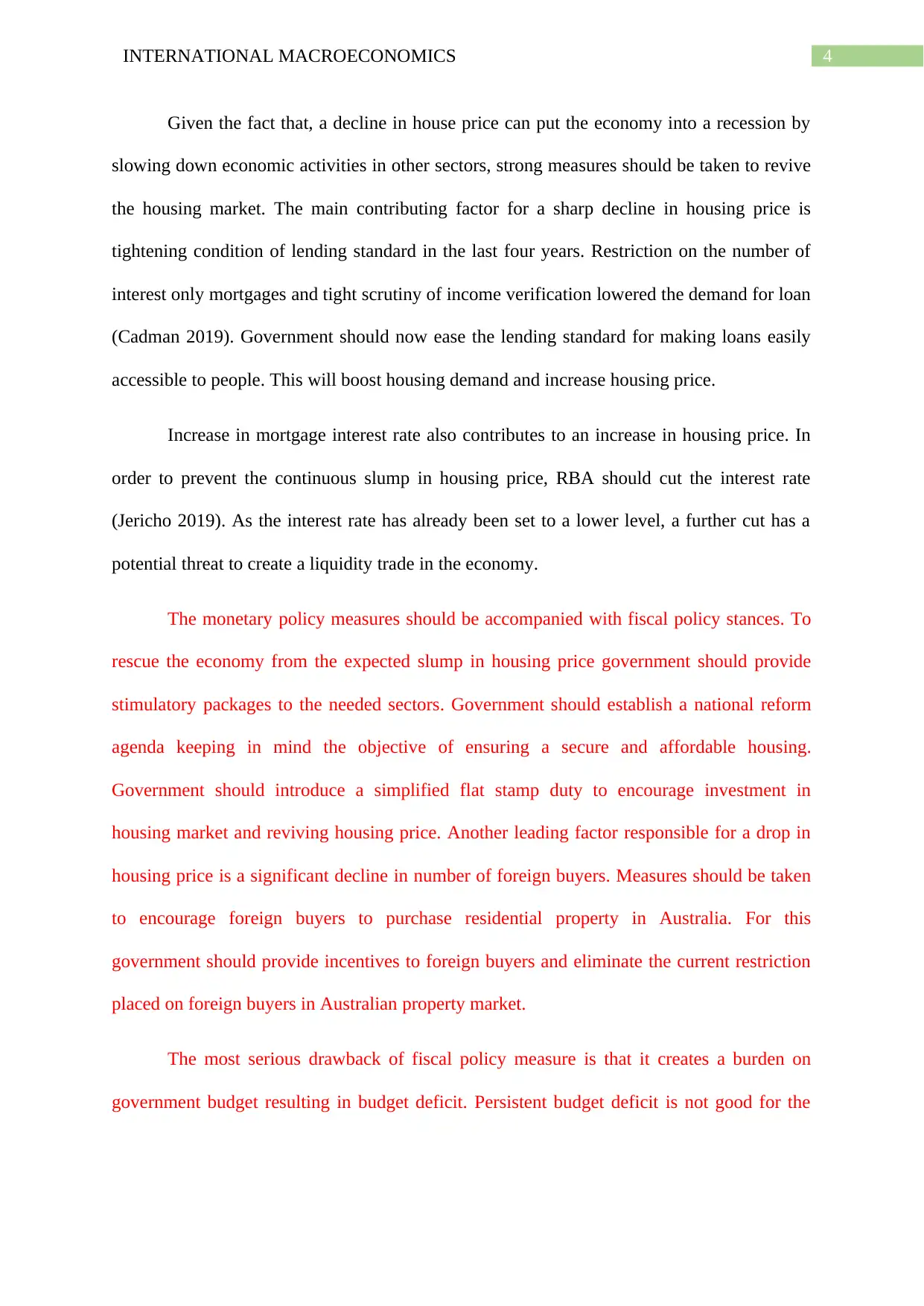
4INTERNATIONAL MACROECONOMICS
Given the fact that, a decline in house price can put the economy into a recession by
slowing down economic activities in other sectors, strong measures should be taken to revive
the housing market. The main contributing factor for a sharp decline in housing price is
tightening condition of lending standard in the last four years. Restriction on the number of
interest only mortgages and tight scrutiny of income verification lowered the demand for loan
(Cadman 2019). Government should now ease the lending standard for making loans easily
accessible to people. This will boost housing demand and increase housing price.
Increase in mortgage interest rate also contributes to an increase in housing price. In
order to prevent the continuous slump in housing price, RBA should cut the interest rate
(Jericho 2019). As the interest rate has already been set to a lower level, a further cut has a
potential threat to create a liquidity trade in the economy.
The monetary policy measures should be accompanied with fiscal policy stances. To
rescue the economy from the expected slump in housing price government should provide
stimulatory packages to the needed sectors. Government should establish a national reform
agenda keeping in mind the objective of ensuring a secure and affordable housing.
Government should introduce a simplified flat stamp duty to encourage investment in
housing market and reviving housing price. Another leading factor responsible for a drop in
housing price is a significant decline in number of foreign buyers. Measures should be taken
to encourage foreign buyers to purchase residential property in Australia. For this
government should provide incentives to foreign buyers and eliminate the current restriction
placed on foreign buyers in Australian property market.
The most serious drawback of fiscal policy measure is that it creates a burden on
government budget resulting in budget deficit. Persistent budget deficit is not good for the
Given the fact that, a decline in house price can put the economy into a recession by
slowing down economic activities in other sectors, strong measures should be taken to revive
the housing market. The main contributing factor for a sharp decline in housing price is
tightening condition of lending standard in the last four years. Restriction on the number of
interest only mortgages and tight scrutiny of income verification lowered the demand for loan
(Cadman 2019). Government should now ease the lending standard for making loans easily
accessible to people. This will boost housing demand and increase housing price.
Increase in mortgage interest rate also contributes to an increase in housing price. In
order to prevent the continuous slump in housing price, RBA should cut the interest rate
(Jericho 2019). As the interest rate has already been set to a lower level, a further cut has a
potential threat to create a liquidity trade in the economy.
The monetary policy measures should be accompanied with fiscal policy stances. To
rescue the economy from the expected slump in housing price government should provide
stimulatory packages to the needed sectors. Government should establish a national reform
agenda keeping in mind the objective of ensuring a secure and affordable housing.
Government should introduce a simplified flat stamp duty to encourage investment in
housing market and reviving housing price. Another leading factor responsible for a drop in
housing price is a significant decline in number of foreign buyers. Measures should be taken
to encourage foreign buyers to purchase residential property in Australia. For this
government should provide incentives to foreign buyers and eliminate the current restriction
placed on foreign buyers in Australian property market.
The most serious drawback of fiscal policy measure is that it creates a burden on
government budget resulting in budget deficit. Persistent budget deficit is not good for the
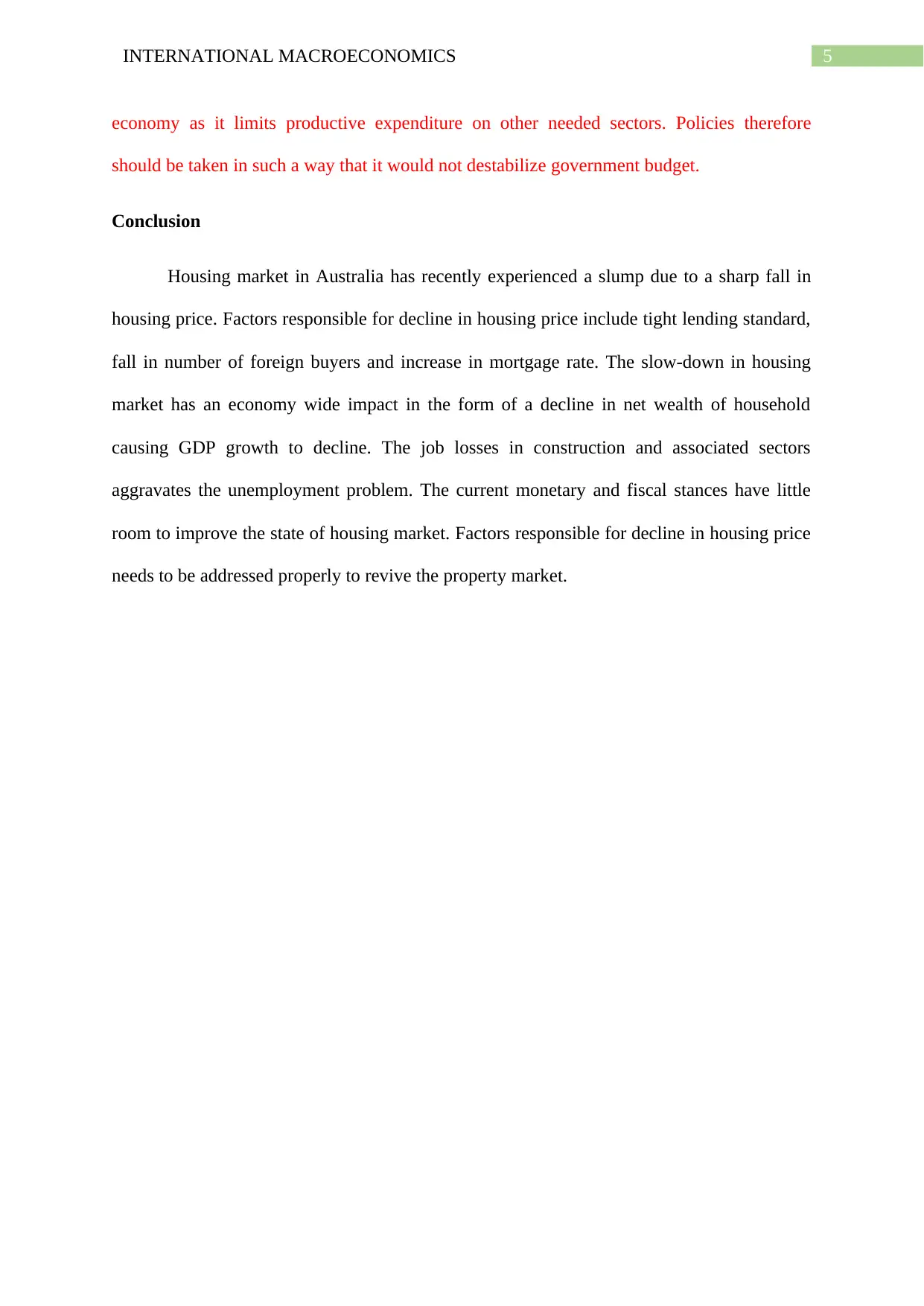
5INTERNATIONAL MACROECONOMICS
economy as it limits productive expenditure on other needed sectors. Policies therefore
should be taken in such a way that it would not destabilize government budget.
Conclusion
Housing market in Australia has recently experienced a slump due to a sharp fall in
housing price. Factors responsible for decline in housing price include tight lending standard,
fall in number of foreign buyers and increase in mortgage rate. The slow-down in housing
market has an economy wide impact in the form of a decline in net wealth of household
causing GDP growth to decline. The job losses in construction and associated sectors
aggravates the unemployment problem. The current monetary and fiscal stances have little
room to improve the state of housing market. Factors responsible for decline in housing price
needs to be addressed properly to revive the property market.
economy as it limits productive expenditure on other needed sectors. Policies therefore
should be taken in such a way that it would not destabilize government budget.
Conclusion
Housing market in Australia has recently experienced a slump due to a sharp fall in
housing price. Factors responsible for decline in housing price include tight lending standard,
fall in number of foreign buyers and increase in mortgage rate. The slow-down in housing
market has an economy wide impact in the form of a decline in net wealth of household
causing GDP growth to decline. The job losses in construction and associated sectors
aggravates the unemployment problem. The current monetary and fiscal stances have little
room to improve the state of housing market. Factors responsible for decline in housing price
needs to be addressed properly to revive the property market.
You're viewing a preview
Unlock full access by subscribing today!
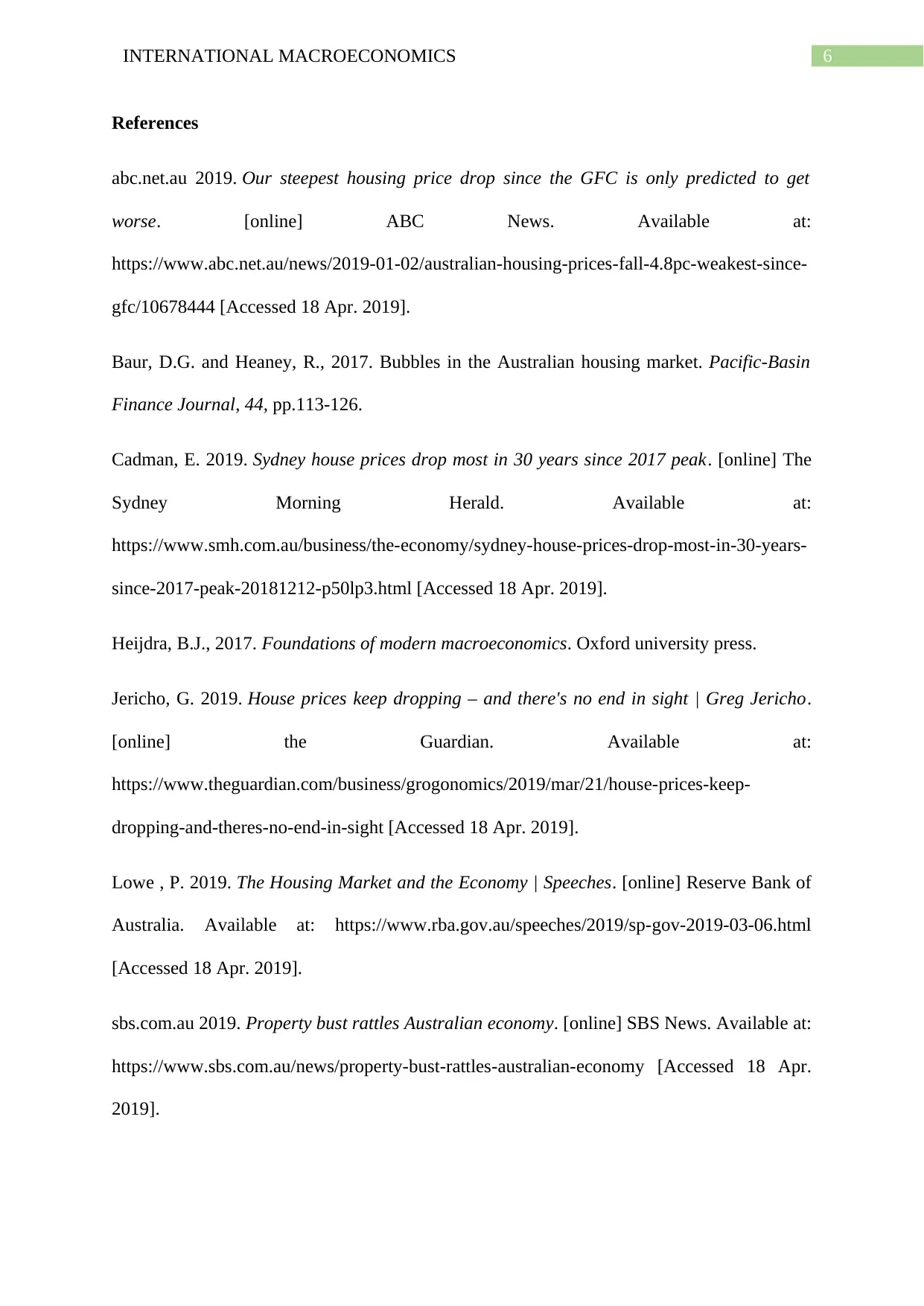
6INTERNATIONAL MACROECONOMICS
References
abc.net.au 2019. Our steepest housing price drop since the GFC is only predicted to get
worse. [online] ABC News. Available at:
https://www.abc.net.au/news/2019-01-02/australian-housing-prices-fall-4.8pc-weakest-since-
gfc/10678444 [Accessed 18 Apr. 2019].
Baur, D.G. and Heaney, R., 2017. Bubbles in the Australian housing market. Pacific-Basin
Finance Journal, 44, pp.113-126.
Cadman, E. 2019. Sydney house prices drop most in 30 years since 2017 peak. [online] The
Sydney Morning Herald. Available at:
https://www.smh.com.au/business/the-economy/sydney-house-prices-drop-most-in-30-years-
since-2017-peak-20181212-p50lp3.html [Accessed 18 Apr. 2019].
Heijdra, B.J., 2017. Foundations of modern macroeconomics. Oxford university press.
Jericho, G. 2019. House prices keep dropping – and there's no end in sight | Greg Jericho.
[online] the Guardian. Available at:
https://www.theguardian.com/business/grogonomics/2019/mar/21/house-prices-keep-
dropping-and-theres-no-end-in-sight [Accessed 18 Apr. 2019].
Lowe , P. 2019. The Housing Market and the Economy | Speeches. [online] Reserve Bank of
Australia. Available at: https://www.rba.gov.au/speeches/2019/sp-gov-2019-03-06.html
[Accessed 18 Apr. 2019].
sbs.com.au 2019. Property bust rattles Australian economy. [online] SBS News. Available at:
https://www.sbs.com.au/news/property-bust-rattles-australian-economy [Accessed 18 Apr.
2019].
References
abc.net.au 2019. Our steepest housing price drop since the GFC is only predicted to get
worse. [online] ABC News. Available at:
https://www.abc.net.au/news/2019-01-02/australian-housing-prices-fall-4.8pc-weakest-since-
gfc/10678444 [Accessed 18 Apr. 2019].
Baur, D.G. and Heaney, R., 2017. Bubbles in the Australian housing market. Pacific-Basin
Finance Journal, 44, pp.113-126.
Cadman, E. 2019. Sydney house prices drop most in 30 years since 2017 peak. [online] The
Sydney Morning Herald. Available at:
https://www.smh.com.au/business/the-economy/sydney-house-prices-drop-most-in-30-years-
since-2017-peak-20181212-p50lp3.html [Accessed 18 Apr. 2019].
Heijdra, B.J., 2017. Foundations of modern macroeconomics. Oxford university press.
Jericho, G. 2019. House prices keep dropping – and there's no end in sight | Greg Jericho.
[online] the Guardian. Available at:
https://www.theguardian.com/business/grogonomics/2019/mar/21/house-prices-keep-
dropping-and-theres-no-end-in-sight [Accessed 18 Apr. 2019].
Lowe , P. 2019. The Housing Market and the Economy | Speeches. [online] Reserve Bank of
Australia. Available at: https://www.rba.gov.au/speeches/2019/sp-gov-2019-03-06.html
[Accessed 18 Apr. 2019].
sbs.com.au 2019. Property bust rattles Australian economy. [online] SBS News. Available at:
https://www.sbs.com.au/news/property-bust-rattles-australian-economy [Accessed 18 Apr.
2019].
Paraphrase This Document
Need a fresh take? Get an instant paraphrase of this document with our AI Paraphraser
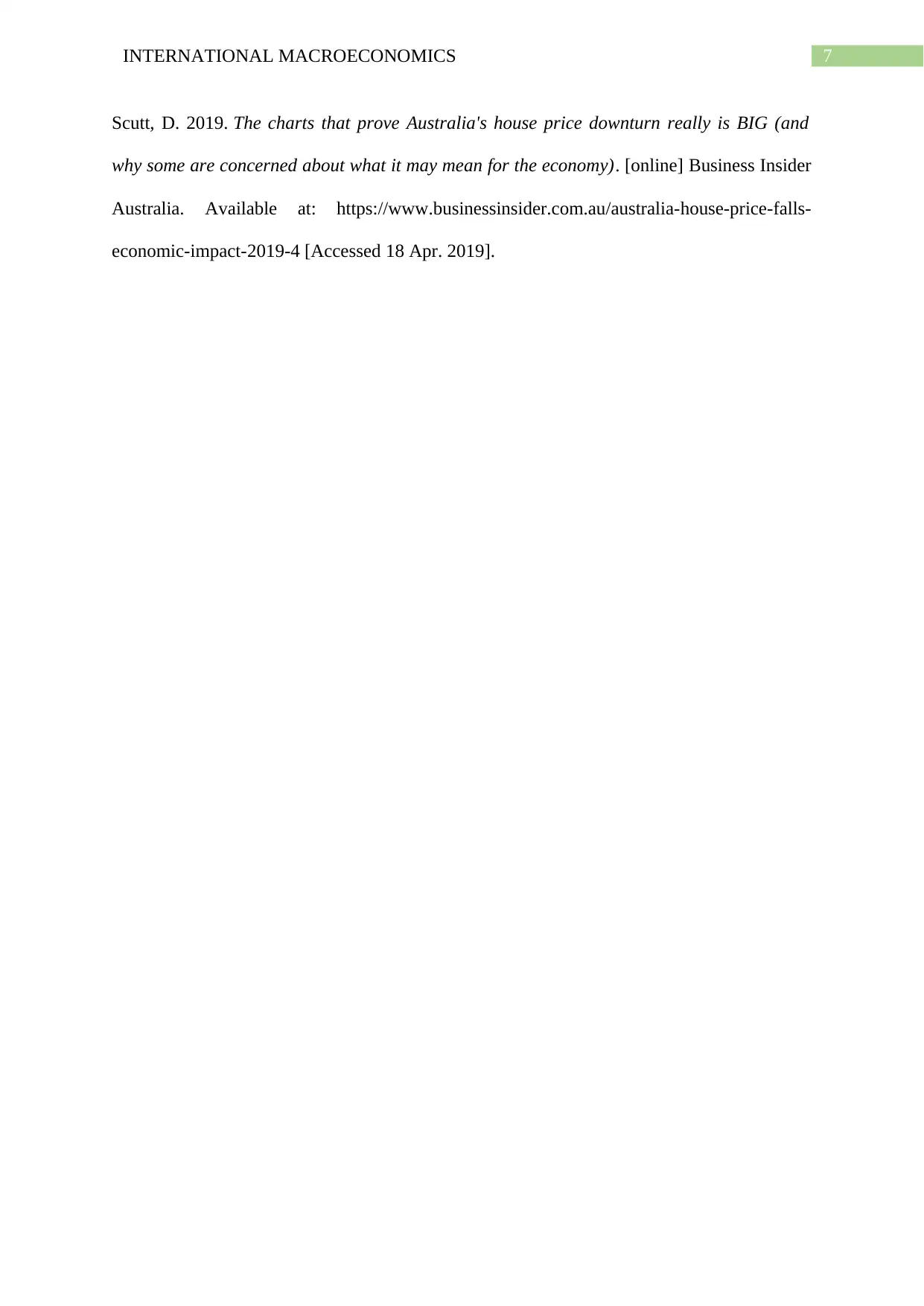
7INTERNATIONAL MACROECONOMICS
Scutt, D. 2019. The charts that prove Australia's house price downturn really is BIG (and
why some are concerned about what it may mean for the economy). [online] Business Insider
Australia. Available at: https://www.businessinsider.com.au/australia-house-price-falls-
economic-impact-2019-4 [Accessed 18 Apr. 2019].
Scutt, D. 2019. The charts that prove Australia's house price downturn really is BIG (and
why some are concerned about what it may mean for the economy). [online] Business Insider
Australia. Available at: https://www.businessinsider.com.au/australia-house-price-falls-
economic-impact-2019-4 [Accessed 18 Apr. 2019].
1 out of 8
Related Documents
Your All-in-One AI-Powered Toolkit for Academic Success.
+13062052269
info@desklib.com
Available 24*7 on WhatsApp / Email
![[object Object]](/_next/static/media/star-bottom.7253800d.svg)
Unlock your academic potential
© 2024 | Zucol Services PVT LTD | All rights reserved.





